A new study by Freeman illustrates the dramatic role event data is playing in helping event professionals deliver bigger and better meetings. “Data Benchmark Study,” which was produced in partnership with Chief Marketer, showed that collecting and analyzing everything from attendance to leads and sales has the potential to positively influence decision-making and help event marketers and planners significantly improve the attendee experience.
Increasing Data Budgets
The study of more than 650 leading marketing executives from many of the world’s largest corporations revealed that event marketers are using the results of event metrics to secure budgets, set strategies, make decisions and positively impact ROI.
The study found that the data is primarily used to increase sales (62 percent) and drive brand awareness (60 percent). Data points collected included qualified leads (37 percent) and website traffic (30 percent).
Related: Tips from HBR for Measuring Event Impact
Additionally, the study found:
- 88 percent of companies surveyed use event data to inform other marketing strategies and decision-making
- 70 percent use event data to enhance event experience
- 63 percent rely on data to improve product development
Event marketers are taking notice of the importance of data, as well. Two out of three professionals surveyed said they plan on increasing spending on data and analytics in 2019. Proper use of data and analytics can potentially improve and add value to attendee experience, data which planners can use in making better, well-informed decisions in the future. “Data is becoming the fuel that powers the marketing mix. It powers the insights that drive critical decision-making at all junctions in both marketing and throughout an organization,” said Freeman vice president of data and analytics Ken Holsinger.
More than half (54 percent) of brands surveyed believe better, more reliable data will mean an increase in attendee quality by at least 21 percent. Event marketers and planners cite creating top-quality, memorable experiences as the goal. Event experiences that attendees remember will almost always result in them not only coming back the next time around but spreading the word to colleagues.
Untapping Potential
Respondents cited the time and complexity of gathering meaningful data as a limiting factor. The survey showed:
- Almost half (46 percent) said the biggest challenge is analyzing event data effectively
- A third, (37 percent) said time and resources required to work with the data were challenges
- A third (37 percent) said a lack of attention given to data analyzing can have a dire effect on its quality and completeness
Not having the time to analyze data is likely correlated to more than half of event marketing teams not having a dedicated team member whose focus is event data and analyzation. Fewer dedicated resources often means less reliable data. The survey found:
- More than half (51 percent) of event marketing teams do not have a dedicated team member whose focus is event data and analyzation
- Almost half (47 percent) of the event marketers surveyed believe that the lack of complete, easy-to-access data makes their events less effective
Related: Infographic: How Effective Event Marketing Boosts ROI
Data in Action
Having a team whose focus is event data and measurement can potentially solve the issue of having incomplete data by creating a pool of data advocates. It would follow that by having complete and easily accessible data, events will become more efficacious, as there would be more reliable data to work with.
An example of effective data analysis can be seen in a case study by Freeman. A trade association experienced a decline in attendance and exhibit space. After comparing the 30,000 attendee companies to the list of registered attendees at this event, it discovered that the highest number of potential attendee companies were in the Southeast region, although the area had the lowest attendee representation. The team identified that the problem was geographical representation. By adding a Southeastern venue to the association and reaching to that pool of potential attendees, attendance was increased by 22 percent in the first year.
Skip Cox, Freeman senior vice president of research and measurement, explained the ROI this way: “Data is a tool, and if your organization is not using it, you’re missing out on reaching and exceeding your potential.”




